Business Law Report: Contracts, Negligence, and Liability
VerifiedAdded on 2019/12/03
|10
|4228
|162
Report
AI Summary
This report provides a comprehensive analysis of contract and negligence principles within a business context. It begins by outlining the essential elements of a valid contract, including offer, acceptance, intention of legal consequences, and consideration. It then explores various types of contracts prevalent in the UK, such as face-to-face, written, distance selling, verbal, and inferred contracts, and examines different terms that can be included in a valid contract, like implied and expressed terms. The report further applies these elements to business situations, analyzing express and implied terms, and exclusion clauses. The report then transitions to the principles of liability in negligence, differentiating between contract and tort liability, discussing the development of the "duty of care" concept with reference to Donoghue v Stevenson, and explaining vicarious liability in business contexts. Finally, it applies these negligence principles to business scenarios, advising on the recovery of losses and the elements of vicarious liability, providing detailed case analysis and legal reasoning.
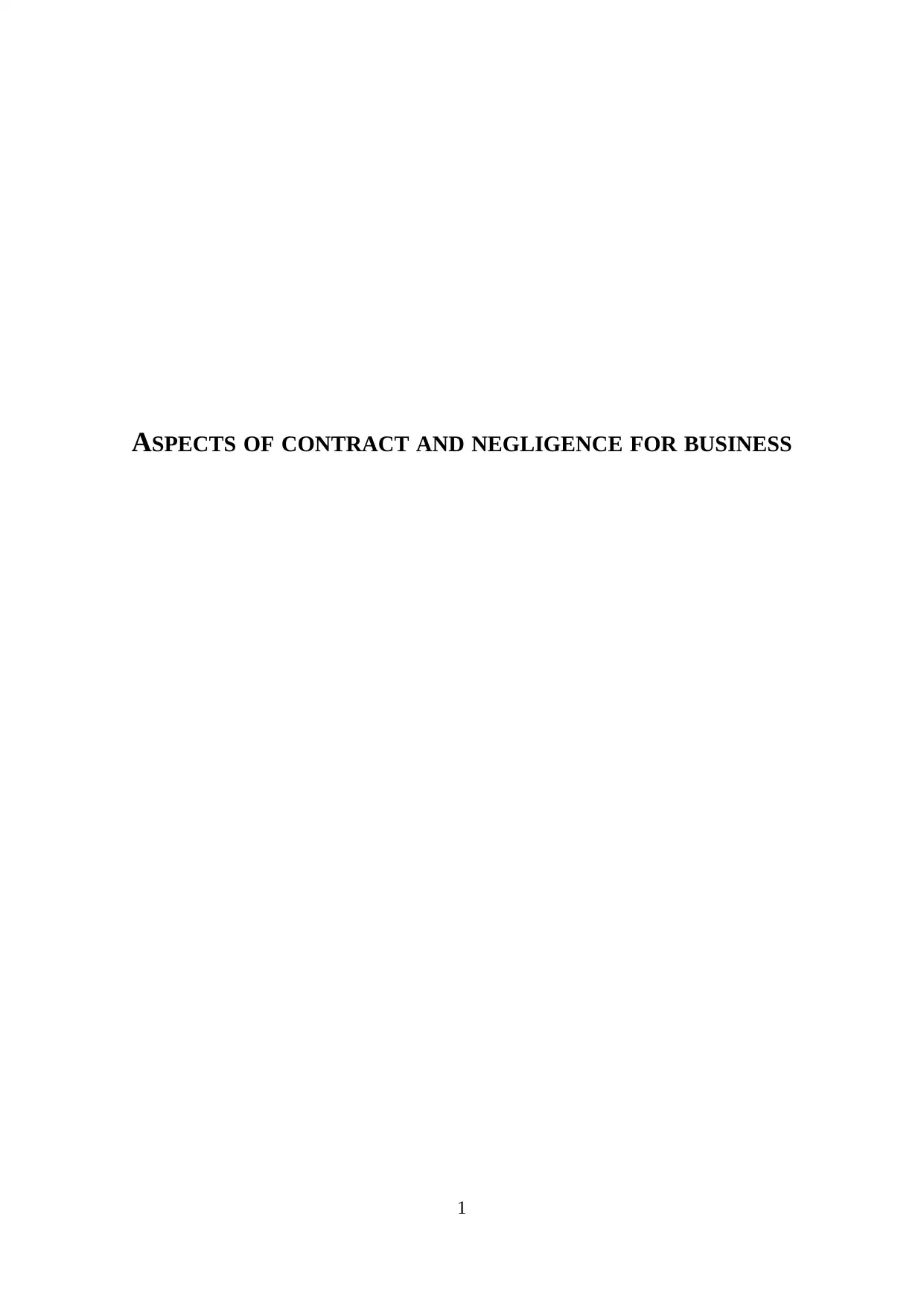
ASPECTS OF CONTRACT AND NEGLIGENCE FOR BUSINESS
1
1
Paraphrase This Document
Need a fresh take? Get an instant paraphrase of this document with our AI Paraphraser
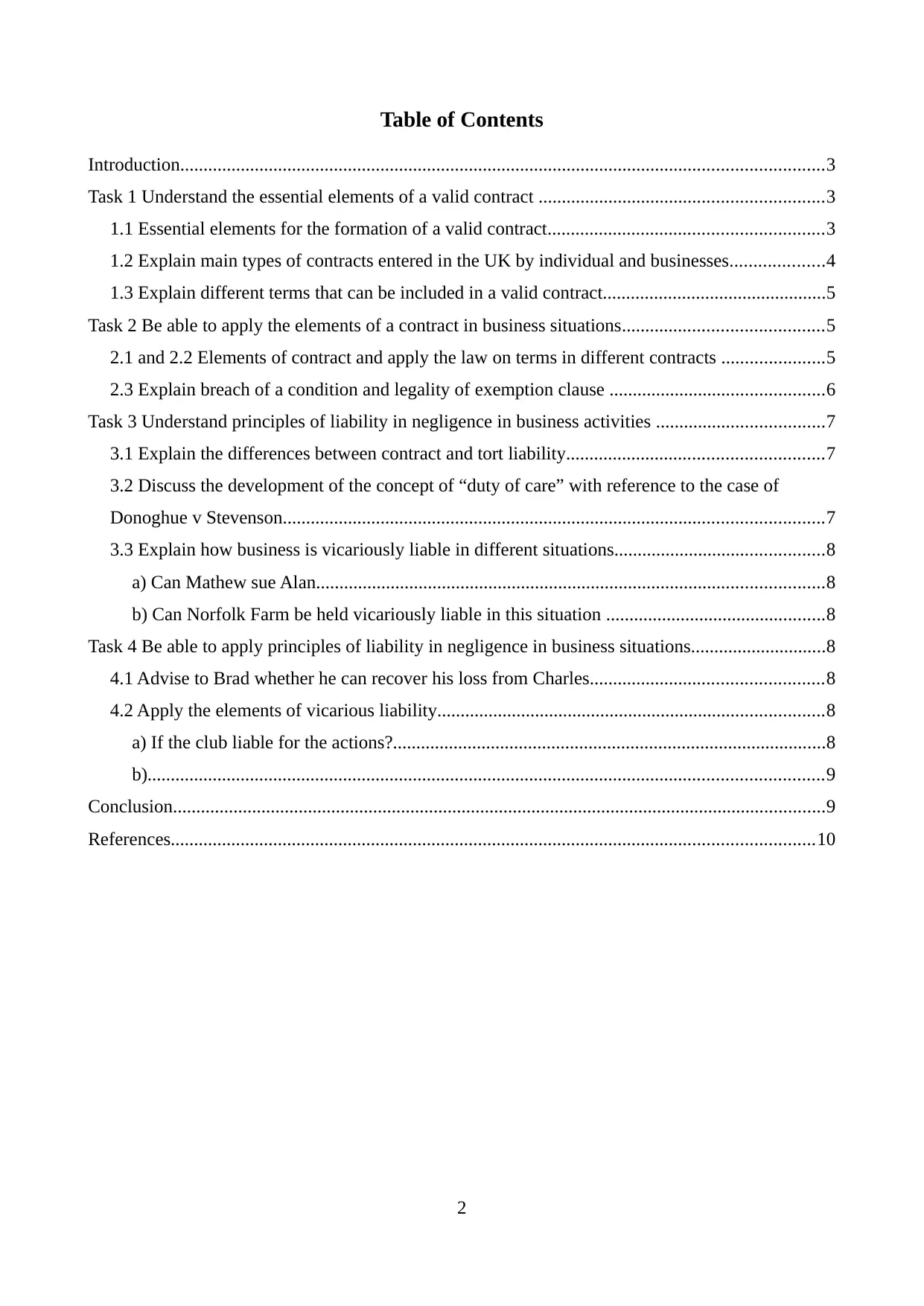
Table of Contents
Introduction..........................................................................................................................................3
Task 1 Understand the essential elements of a valid contract .............................................................3
1.1 Essential elements for the formation of a valid contract...........................................................3
1.2 Explain main types of contracts entered in the UK by individual and businesses....................4
1.3 Explain different terms that can be included in a valid contract................................................5
Task 2 Be able to apply the elements of a contract in business situations...........................................5
2.1 and 2.2 Elements of contract and apply the law on terms in different contracts ......................5
2.3 Explain breach of a condition and legality of exemption clause ..............................................6
Task 3 Understand principles of liability in negligence in business activities ....................................7
3.1 Explain the differences between contract and tort liability.......................................................7
3.2 Discuss the development of the concept of “duty of care” with reference to the case of
Donoghue v Stevenson....................................................................................................................7
3.3 Explain how business is vicariously liable in different situations.............................................8
a) Can Mathew sue Alan.............................................................................................................8
b) Can Norfolk Farm be held vicariously liable in this situation ...............................................8
Task 4 Be able to apply principles of liability in negligence in business situations.............................8
4.1 Advise to Brad whether he can recover his loss from Charles..................................................8
4.2 Apply the elements of vicarious liability...................................................................................8
a) If the club liable for the actions?.............................................................................................8
b).................................................................................................................................................9
Conclusion............................................................................................................................................9
References..........................................................................................................................................10
2
Introduction..........................................................................................................................................3
Task 1 Understand the essential elements of a valid contract .............................................................3
1.1 Essential elements for the formation of a valid contract...........................................................3
1.2 Explain main types of contracts entered in the UK by individual and businesses....................4
1.3 Explain different terms that can be included in a valid contract................................................5
Task 2 Be able to apply the elements of a contract in business situations...........................................5
2.1 and 2.2 Elements of contract and apply the law on terms in different contracts ......................5
2.3 Explain breach of a condition and legality of exemption clause ..............................................6
Task 3 Understand principles of liability in negligence in business activities ....................................7
3.1 Explain the differences between contract and tort liability.......................................................7
3.2 Discuss the development of the concept of “duty of care” with reference to the case of
Donoghue v Stevenson....................................................................................................................7
3.3 Explain how business is vicariously liable in different situations.............................................8
a) Can Mathew sue Alan.............................................................................................................8
b) Can Norfolk Farm be held vicariously liable in this situation ...............................................8
Task 4 Be able to apply principles of liability in negligence in business situations.............................8
4.1 Advise to Brad whether he can recover his loss from Charles..................................................8
4.2 Apply the elements of vicarious liability...................................................................................8
a) If the club liable for the actions?.............................................................................................8
b).................................................................................................................................................9
Conclusion............................................................................................................................................9
References..........................................................................................................................................10
2
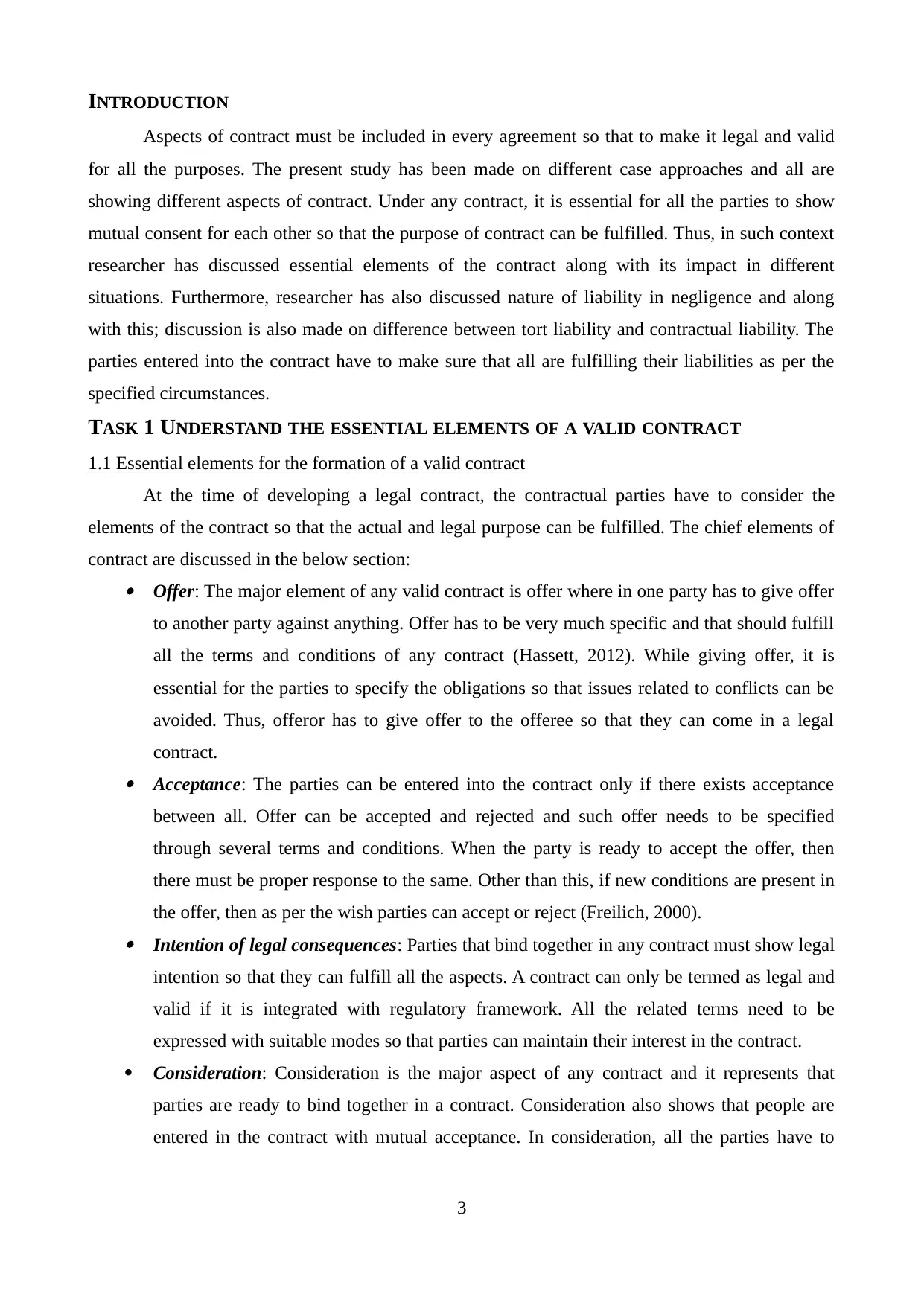
INTRODUCTION
Aspects of contract must be included in every agreement so that to make it legal and valid
for all the purposes. The present study has been made on different case approaches and all are
showing different aspects of contract. Under any contract, it is essential for all the parties to show
mutual consent for each other so that the purpose of contract can be fulfilled. Thus, in such context
researcher has discussed essential elements of the contract along with its impact in different
situations. Furthermore, researcher has also discussed nature of liability in negligence and along
with this; discussion is also made on difference between tort liability and contractual liability. The
parties entered into the contract have to make sure that all are fulfilling their liabilities as per the
specified circumstances.
TASK 1 UNDERSTAND THE ESSENTIAL ELEMENTS OF A VALID CONTRACT
1.1 Essential elements for the formation of a valid contract
At the time of developing a legal contract, the contractual parties have to consider the
elements of the contract so that the actual and legal purpose can be fulfilled. The chief elements of
contract are discussed in the below section: Offer: The major element of any valid contract is offer where in one party has to give offer
to another party against anything. Offer has to be very much specific and that should fulfill
all the terms and conditions of any contract (Hassett, 2012). While giving offer, it is
essential for the parties to specify the obligations so that issues related to conflicts can be
avoided. Thus, offeror has to give offer to the offeree so that they can come in a legal
contract. Acceptance: The parties can be entered into the contract only if there exists acceptance
between all. Offer can be accepted and rejected and such offer needs to be specified
through several terms and conditions. When the party is ready to accept the offer, then
there must be proper response to the same. Other than this, if new conditions are present in
the offer, then as per the wish parties can accept or reject (Freilich, 2000). Intention of legal consequences: Parties that bind together in any contract must show legal
intention so that they can fulfill all the aspects. A contract can only be termed as legal and
valid if it is integrated with regulatory framework. All the related terms need to be
expressed with suitable modes so that parties can maintain their interest in the contract.
Consideration: Consideration is the major aspect of any contract and it represents that
parties are ready to bind together in a contract. Consideration also shows that people are
entered in the contract with mutual acceptance. In consideration, all the parties have to
3
Aspects of contract must be included in every agreement so that to make it legal and valid
for all the purposes. The present study has been made on different case approaches and all are
showing different aspects of contract. Under any contract, it is essential for all the parties to show
mutual consent for each other so that the purpose of contract can be fulfilled. Thus, in such context
researcher has discussed essential elements of the contract along with its impact in different
situations. Furthermore, researcher has also discussed nature of liability in negligence and along
with this; discussion is also made on difference between tort liability and contractual liability. The
parties entered into the contract have to make sure that all are fulfilling their liabilities as per the
specified circumstances.
TASK 1 UNDERSTAND THE ESSENTIAL ELEMENTS OF A VALID CONTRACT
1.1 Essential elements for the formation of a valid contract
At the time of developing a legal contract, the contractual parties have to consider the
elements of the contract so that the actual and legal purpose can be fulfilled. The chief elements of
contract are discussed in the below section: Offer: The major element of any valid contract is offer where in one party has to give offer
to another party against anything. Offer has to be very much specific and that should fulfill
all the terms and conditions of any contract (Hassett, 2012). While giving offer, it is
essential for the parties to specify the obligations so that issues related to conflicts can be
avoided. Thus, offeror has to give offer to the offeree so that they can come in a legal
contract. Acceptance: The parties can be entered into the contract only if there exists acceptance
between all. Offer can be accepted and rejected and such offer needs to be specified
through several terms and conditions. When the party is ready to accept the offer, then
there must be proper response to the same. Other than this, if new conditions are present in
the offer, then as per the wish parties can accept or reject (Freilich, 2000). Intention of legal consequences: Parties that bind together in any contract must show legal
intention so that they can fulfill all the aspects. A contract can only be termed as legal and
valid if it is integrated with regulatory framework. All the related terms need to be
expressed with suitable modes so that parties can maintain their interest in the contract.
Consideration: Consideration is the major aspect of any contract and it represents that
parties are ready to bind together in a contract. Consideration also shows that people are
entered in the contract with mutual acceptance. In consideration, all the parties have to
3
⊘ This is a preview!⊘
Do you want full access?
Subscribe today to unlock all pages.

Trusted by 1+ million students worldwide

promise each other regarding the return of doing something for another.
Every contract should be formulated on the basis of valuable consideration which specifies
mutual agreement from both the parties (Freilich, 2000). Thus, it can be said that one party
promises to do something in return for a promise to another party to provide a benefit of
value.
As per the present case of James, the concept of “Invitation to treat” can be seen. James had
advertised the camera for £55 and considering the same. Maria responded but she asked for
negotiation as she wanted to purchase it in £45. For this offer, James responded that he would sell
the camera in the original price only and this shows that he made counter offer. Maria did not
respond anything to James; hence James again wrote to Maria that he is ready to accept the offer.
James actually is not entitled to offer now since he already made other offer prior to this.
1.2 Explain main types of contracts entered in the UK by individual and businesses
Different types of contract can be used for different situations; however all the contracts
should be integrated with legal aspects. The types are as follows: Face to face contract: Face to face contracts are useful for the business entities since that
assists them to clarify each and everything related to purpose of the contract (Zamore,
2014). Clear communication and consistent meetings are required to develop a face to face
communication. Actual presence of the parties is must in the contract. Written contract: Written contract is the one that can be developed on the basis of several
criteria and parameters. The terms and conditions of all the parties are properly mentioned
in the written contract and this also gives the benefit of evidence. Most of the business
entities prefer to form such contract (Rohrmann, Cunha and Falci, 2015). Distance selling: In distance contract, parties who are far from each other develops contract
and this can be formulated through diversified communication modes. This can be
formulated when parties are unable to meet other entities. All the terms and conditions are
communicated to others through telephones, fax machines and other electronic sources.
Distance selling contract reflects the validity of online management of goods and services.
Hence, parties are not required to emphasize on direct meetings (Powers, 2008). Verbal contract: One can develop verbal contract through speaking and discussing things
and the main thing required here in the contract is mutual trust and faith between the
parties. The parties have to be very much clear about the legal aspects because nothing is
specified in the actual contract. Evidence cannot be derived in such contract and due to this,
parties cannot claim for the damages as well.
Inferred contract: Inferred contract and implied contracts are one and the same and they
4
Every contract should be formulated on the basis of valuable consideration which specifies
mutual agreement from both the parties (Freilich, 2000). Thus, it can be said that one party
promises to do something in return for a promise to another party to provide a benefit of
value.
As per the present case of James, the concept of “Invitation to treat” can be seen. James had
advertised the camera for £55 and considering the same. Maria responded but she asked for
negotiation as she wanted to purchase it in £45. For this offer, James responded that he would sell
the camera in the original price only and this shows that he made counter offer. Maria did not
respond anything to James; hence James again wrote to Maria that he is ready to accept the offer.
James actually is not entitled to offer now since he already made other offer prior to this.
1.2 Explain main types of contracts entered in the UK by individual and businesses
Different types of contract can be used for different situations; however all the contracts
should be integrated with legal aspects. The types are as follows: Face to face contract: Face to face contracts are useful for the business entities since that
assists them to clarify each and everything related to purpose of the contract (Zamore,
2014). Clear communication and consistent meetings are required to develop a face to face
communication. Actual presence of the parties is must in the contract. Written contract: Written contract is the one that can be developed on the basis of several
criteria and parameters. The terms and conditions of all the parties are properly mentioned
in the written contract and this also gives the benefit of evidence. Most of the business
entities prefer to form such contract (Rohrmann, Cunha and Falci, 2015). Distance selling: In distance contract, parties who are far from each other develops contract
and this can be formulated through diversified communication modes. This can be
formulated when parties are unable to meet other entities. All the terms and conditions are
communicated to others through telephones, fax machines and other electronic sources.
Distance selling contract reflects the validity of online management of goods and services.
Hence, parties are not required to emphasize on direct meetings (Powers, 2008). Verbal contract: One can develop verbal contract through speaking and discussing things
and the main thing required here in the contract is mutual trust and faith between the
parties. The parties have to be very much clear about the legal aspects because nothing is
specified in the actual contract. Evidence cannot be derived in such contract and due to this,
parties cannot claim for the damages as well.
Inferred contract: Inferred contract and implied contracts are one and the same and they
4
Paraphrase This Document
Need a fresh take? Get an instant paraphrase of this document with our AI Paraphraser

can be formed through conducting acts only. Offer can be given through specific actions
and on that basis, parties can give their consideration.
1.3 Explain different terms that can be included in a valid contract Implied terms: Implied terms cannot be directly inserted into any contract as these specify
those terms that are apparent to be followed (Palmer, 2014). While developing the contract,
the parties have to fulfill all the legal rules and norms. The value of contractual agreement
can be increased if every aspect is properly mentioned in the contract. Thus, it is evident that
implied terms can be applied into the contracts if specified by the courts and other statutes. Expressed terms: Expressed terms are mentioned in the contract and parties have to adhere
those terms since they are inserted by considering legal facets. However, these terms can be
verbally or non verbally stated in the contract (Giliker, 2010).1. Warranties – Warranties is the situation in which one party promises another party to
perform the peculiar task. Warranties can be in the kind of implied and express terms.
Furthermore, in case of warranties if any party breach the contract than in that case the
innocent party is full liable to claim a compensation for the damage cause to him. But he is
not liable to break the contract.2. Conditions – Conditions can be representing as a root of the contract. It can occur in form of
implied and express terms. Conditions of the contract depend on the situation (Gilead,
2009). Further, it can be said that if condition is breached by any party; than in that case
defendant party is liable to pay a sum of compensation to the innocent party. In addition to
which innocent is also eligible to break the contract in case of breach.
3. Innominate terms – innominate terms are not the terms which can be expressed as warranty
nor can it be expressed as conditions. Appearance of innominate terms depends on the
situation.
TASK 2 BE ABLE TO APPLY THE ELEMENTS OF A CONTRACT IN BUSINESS
SITUATIONS
2.1 And 2.2 Elements of contract and apply the law on terms in different contracts
Purchasing party – Hair 4 U
Selling party – Bella UK
Contract – Selling of 10 boxes of oil at 5 rupees.
Considering the present case, it has been analyzed that Bella UK produced a new shampoo called
“Miracle oil” that claims rapid hair growth. The company decided to sell the product only in half
price every ten boxes. Several things are described in the advertisement. Hair 4 U showed interest
5
and on that basis, parties can give their consideration.
1.3 Explain different terms that can be included in a valid contract Implied terms: Implied terms cannot be directly inserted into any contract as these specify
those terms that are apparent to be followed (Palmer, 2014). While developing the contract,
the parties have to fulfill all the legal rules and norms. The value of contractual agreement
can be increased if every aspect is properly mentioned in the contract. Thus, it is evident that
implied terms can be applied into the contracts if specified by the courts and other statutes. Expressed terms: Expressed terms are mentioned in the contract and parties have to adhere
those terms since they are inserted by considering legal facets. However, these terms can be
verbally or non verbally stated in the contract (Giliker, 2010).1. Warranties – Warranties is the situation in which one party promises another party to
perform the peculiar task. Warranties can be in the kind of implied and express terms.
Furthermore, in case of warranties if any party breach the contract than in that case the
innocent party is full liable to claim a compensation for the damage cause to him. But he is
not liable to break the contract.2. Conditions – Conditions can be representing as a root of the contract. It can occur in form of
implied and express terms. Conditions of the contract depend on the situation (Gilead,
2009). Further, it can be said that if condition is breached by any party; than in that case
defendant party is liable to pay a sum of compensation to the innocent party. In addition to
which innocent is also eligible to break the contract in case of breach.
3. Innominate terms – innominate terms are not the terms which can be expressed as warranty
nor can it be expressed as conditions. Appearance of innominate terms depends on the
situation.
TASK 2 BE ABLE TO APPLY THE ELEMENTS OF A CONTRACT IN BUSINESS
SITUATIONS
2.1 And 2.2 Elements of contract and apply the law on terms in different contracts
Purchasing party – Hair 4 U
Selling party – Bella UK
Contract – Selling of 10 boxes of oil at 5 rupees.
Considering the present case, it has been analyzed that Bella UK produced a new shampoo called
“Miracle oil” that claims rapid hair growth. The company decided to sell the product only in half
price every ten boxes. Several things are described in the advertisement. Hair 4 U showed interest
5
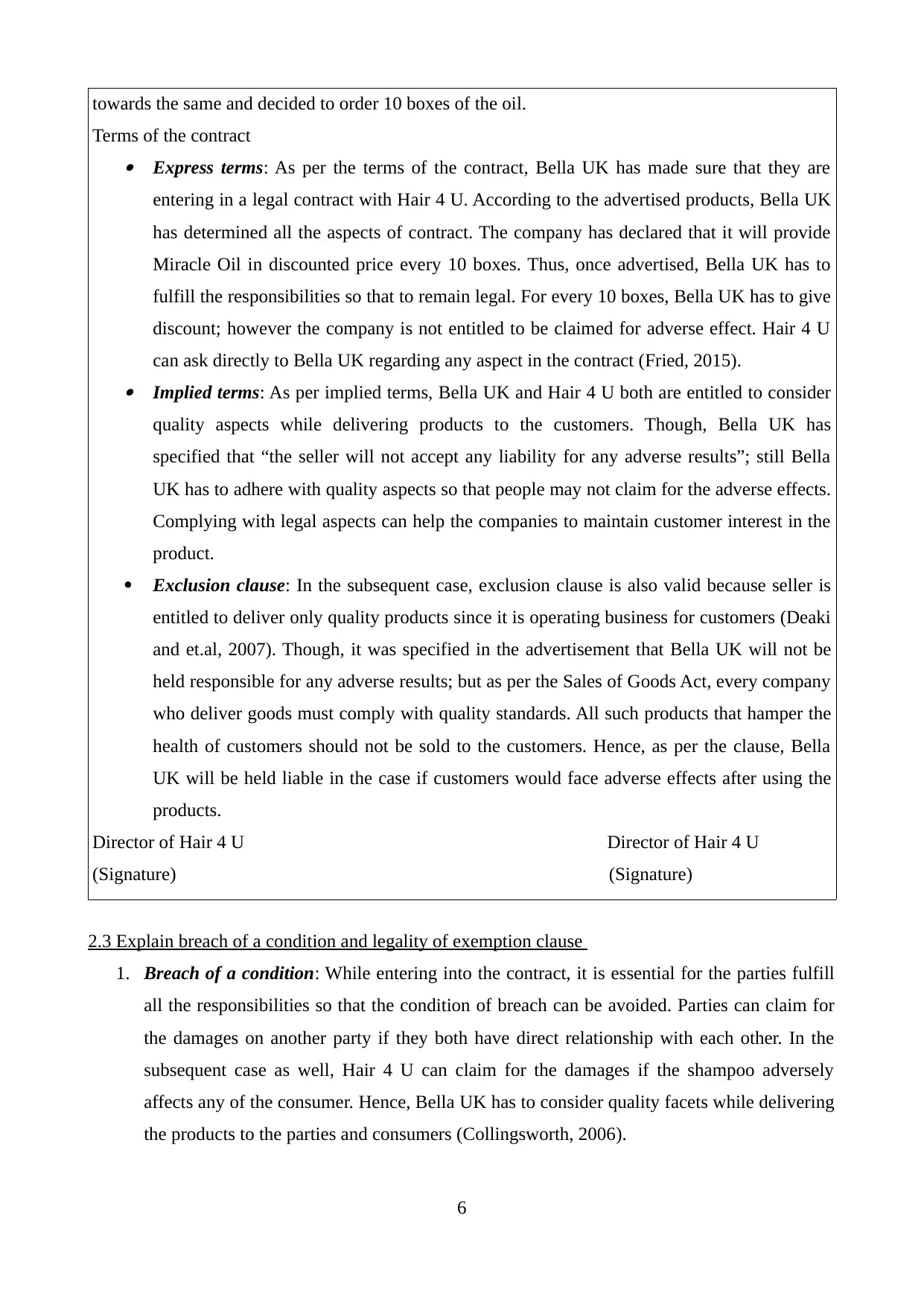
towards the same and decided to order 10 boxes of the oil.
Terms of the contract Express terms: As per the terms of the contract, Bella UK has made sure that they are
entering in a legal contract with Hair 4 U. According to the advertised products, Bella UK
has determined all the aspects of contract. The company has declared that it will provide
Miracle Oil in discounted price every 10 boxes. Thus, once advertised, Bella UK has to
fulfill the responsibilities so that to remain legal. For every 10 boxes, Bella UK has to give
discount; however the company is not entitled to be claimed for adverse effect. Hair 4 U
can ask directly to Bella UK regarding any aspect in the contract (Fried, 2015). Implied terms: As per implied terms, Bella UK and Hair 4 U both are entitled to consider
quality aspects while delivering products to the customers. Though, Bella UK has
specified that “the seller will not accept any liability for any adverse results”; still Bella
UK has to adhere with quality aspects so that people may not claim for the adverse effects.
Complying with legal aspects can help the companies to maintain customer interest in the
product.
Exclusion clause: In the subsequent case, exclusion clause is also valid because seller is
entitled to deliver only quality products since it is operating business for customers (Deaki
and et.al, 2007). Though, it was specified in the advertisement that Bella UK will not be
held responsible for any adverse results; but as per the Sales of Goods Act, every company
who deliver goods must comply with quality standards. All such products that hamper the
health of customers should not be sold to the customers. Hence, as per the clause, Bella
UK will be held liable in the case if customers would face adverse effects after using the
products.
Director of Hair 4 U Director of Hair 4 U
(Signature) (Signature)
2.3 Explain breach of a condition and legality of exemption clause
1. Breach of a condition: While entering into the contract, it is essential for the parties fulfill
all the responsibilities so that the condition of breach can be avoided. Parties can claim for
the damages on another party if they both have direct relationship with each other. In the
subsequent case as well, Hair 4 U can claim for the damages if the shampoo adversely
affects any of the consumer. Hence, Bella UK has to consider quality facets while delivering
the products to the parties and consumers (Collingsworth, 2006).
6
Terms of the contract Express terms: As per the terms of the contract, Bella UK has made sure that they are
entering in a legal contract with Hair 4 U. According to the advertised products, Bella UK
has determined all the aspects of contract. The company has declared that it will provide
Miracle Oil in discounted price every 10 boxes. Thus, once advertised, Bella UK has to
fulfill the responsibilities so that to remain legal. For every 10 boxes, Bella UK has to give
discount; however the company is not entitled to be claimed for adverse effect. Hair 4 U
can ask directly to Bella UK regarding any aspect in the contract (Fried, 2015). Implied terms: As per implied terms, Bella UK and Hair 4 U both are entitled to consider
quality aspects while delivering products to the customers. Though, Bella UK has
specified that “the seller will not accept any liability for any adverse results”; still Bella
UK has to adhere with quality aspects so that people may not claim for the adverse effects.
Complying with legal aspects can help the companies to maintain customer interest in the
product.
Exclusion clause: In the subsequent case, exclusion clause is also valid because seller is
entitled to deliver only quality products since it is operating business for customers (Deaki
and et.al, 2007). Though, it was specified in the advertisement that Bella UK will not be
held responsible for any adverse results; but as per the Sales of Goods Act, every company
who deliver goods must comply with quality standards. All such products that hamper the
health of customers should not be sold to the customers. Hence, as per the clause, Bella
UK will be held liable in the case if customers would face adverse effects after using the
products.
Director of Hair 4 U Director of Hair 4 U
(Signature) (Signature)
2.3 Explain breach of a condition and legality of exemption clause
1. Breach of a condition: While entering into the contract, it is essential for the parties fulfill
all the responsibilities so that the condition of breach can be avoided. Parties can claim for
the damages on another party if they both have direct relationship with each other. In the
subsequent case as well, Hair 4 U can claim for the damages if the shampoo adversely
affects any of the consumer. Hence, Bella UK has to consider quality facets while delivering
the products to the parties and consumers (Collingsworth, 2006).
6
⊘ This is a preview!⊘
Do you want full access?
Subscribe today to unlock all pages.

Trusted by 1+ million students worldwide
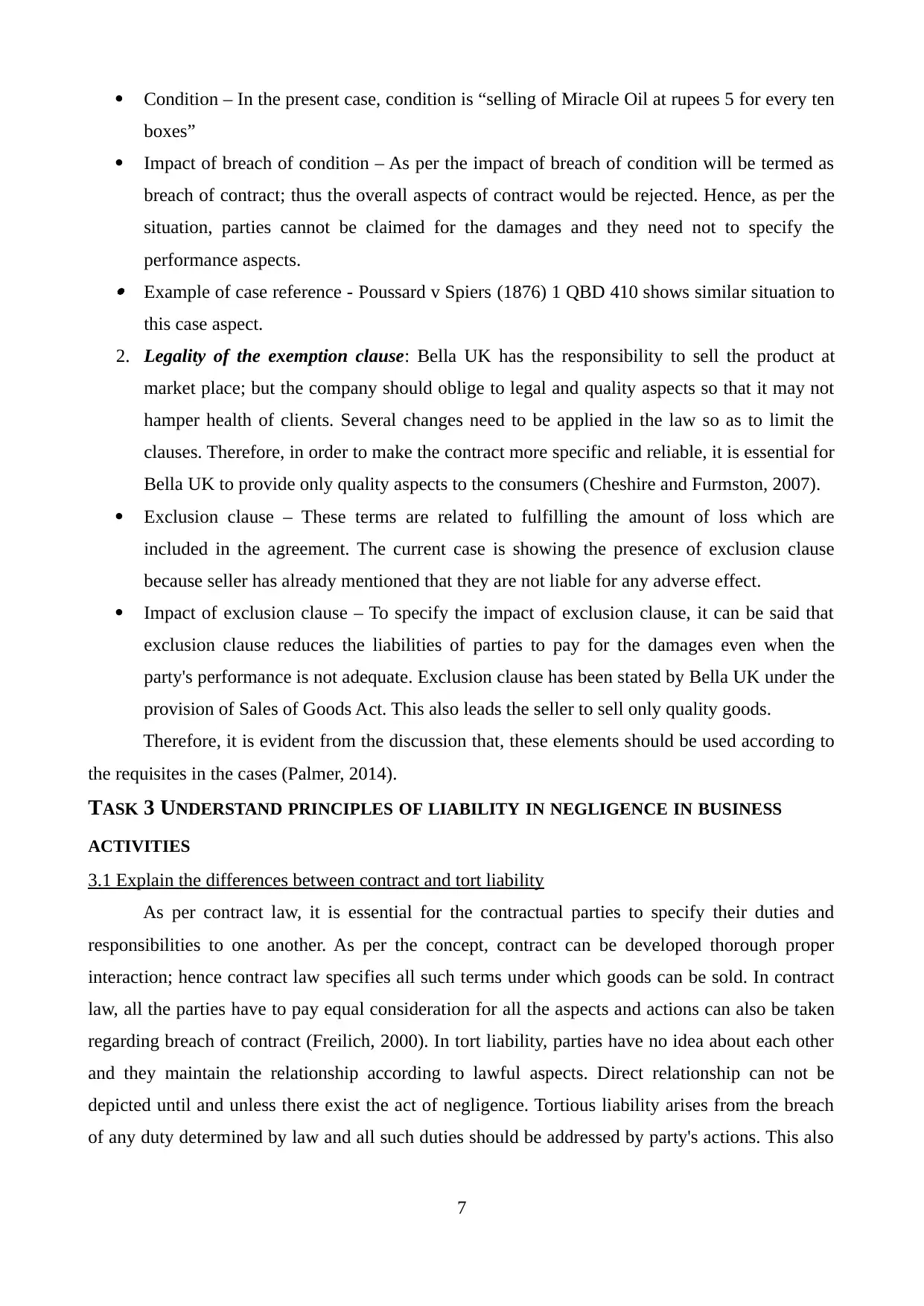
Condition – In the present case, condition is “selling of Miracle Oil at rupees 5 for every ten
boxes”
Impact of breach of condition – As per the impact of breach of condition will be termed as
breach of contract; thus the overall aspects of contract would be rejected. Hence, as per the
situation, parties cannot be claimed for the damages and they need not to specify the
performance aspects. Example of case reference - Poussard v Spiers (1876) 1 QBD 410 shows similar situation to
this case aspect.
2. Legality of the exemption clause: Bella UK has the responsibility to sell the product at
market place; but the company should oblige to legal and quality aspects so that it may not
hamper health of clients. Several changes need to be applied in the law so as to limit the
clauses. Therefore, in order to make the contract more specific and reliable, it is essential for
Bella UK to provide only quality aspects to the consumers (Cheshire and Furmston, 2007).
Exclusion clause – These terms are related to fulfilling the amount of loss which are
included in the agreement. The current case is showing the presence of exclusion clause
because seller has already mentioned that they are not liable for any adverse effect.
Impact of exclusion clause – To specify the impact of exclusion clause, it can be said that
exclusion clause reduces the liabilities of parties to pay for the damages even when the
party's performance is not adequate. Exclusion clause has been stated by Bella UK under the
provision of Sales of Goods Act. This also leads the seller to sell only quality goods.
Therefore, it is evident from the discussion that, these elements should be used according to
the requisites in the cases (Palmer, 2014).
TASK 3 UNDERSTAND PRINCIPLES OF LIABILITY IN NEGLIGENCE IN BUSINESS
ACTIVITIES
3.1 Explain the differences between contract and tort liability
As per contract law, it is essential for the contractual parties to specify their duties and
responsibilities to one another. As per the concept, contract can be developed thorough proper
interaction; hence contract law specifies all such terms under which goods can be sold. In contract
law, all the parties have to pay equal consideration for all the aspects and actions can also be taken
regarding breach of contract (Freilich, 2000). In tort liability, parties have no idea about each other
and they maintain the relationship according to lawful aspects. Direct relationship can not be
depicted until and unless there exist the act of negligence. Tortious liability arises from the breach
of any duty determined by law and all such duties should be addressed by party's actions. This also
7
boxes”
Impact of breach of condition – As per the impact of breach of condition will be termed as
breach of contract; thus the overall aspects of contract would be rejected. Hence, as per the
situation, parties cannot be claimed for the damages and they need not to specify the
performance aspects. Example of case reference - Poussard v Spiers (1876) 1 QBD 410 shows similar situation to
this case aspect.
2. Legality of the exemption clause: Bella UK has the responsibility to sell the product at
market place; but the company should oblige to legal and quality aspects so that it may not
hamper health of clients. Several changes need to be applied in the law so as to limit the
clauses. Therefore, in order to make the contract more specific and reliable, it is essential for
Bella UK to provide only quality aspects to the consumers (Cheshire and Furmston, 2007).
Exclusion clause – These terms are related to fulfilling the amount of loss which are
included in the agreement. The current case is showing the presence of exclusion clause
because seller has already mentioned that they are not liable for any adverse effect.
Impact of exclusion clause – To specify the impact of exclusion clause, it can be said that
exclusion clause reduces the liabilities of parties to pay for the damages even when the
party's performance is not adequate. Exclusion clause has been stated by Bella UK under the
provision of Sales of Goods Act. This also leads the seller to sell only quality goods.
Therefore, it is evident from the discussion that, these elements should be used according to
the requisites in the cases (Palmer, 2014).
TASK 3 UNDERSTAND PRINCIPLES OF LIABILITY IN NEGLIGENCE IN BUSINESS
ACTIVITIES
3.1 Explain the differences between contract and tort liability
As per contract law, it is essential for the contractual parties to specify their duties and
responsibilities to one another. As per the concept, contract can be developed thorough proper
interaction; hence contract law specifies all such terms under which goods can be sold. In contract
law, all the parties have to pay equal consideration for all the aspects and actions can also be taken
regarding breach of contract (Freilich, 2000). In tort liability, parties have no idea about each other
and they maintain the relationship according to lawful aspects. Direct relationship can not be
depicted until and unless there exist the act of negligence. Tortious liability arises from the breach
of any duty determined by law and all such duties should be addressed by party's actions. This also
7
Paraphrase This Document
Need a fresh take? Get an instant paraphrase of this document with our AI Paraphraser
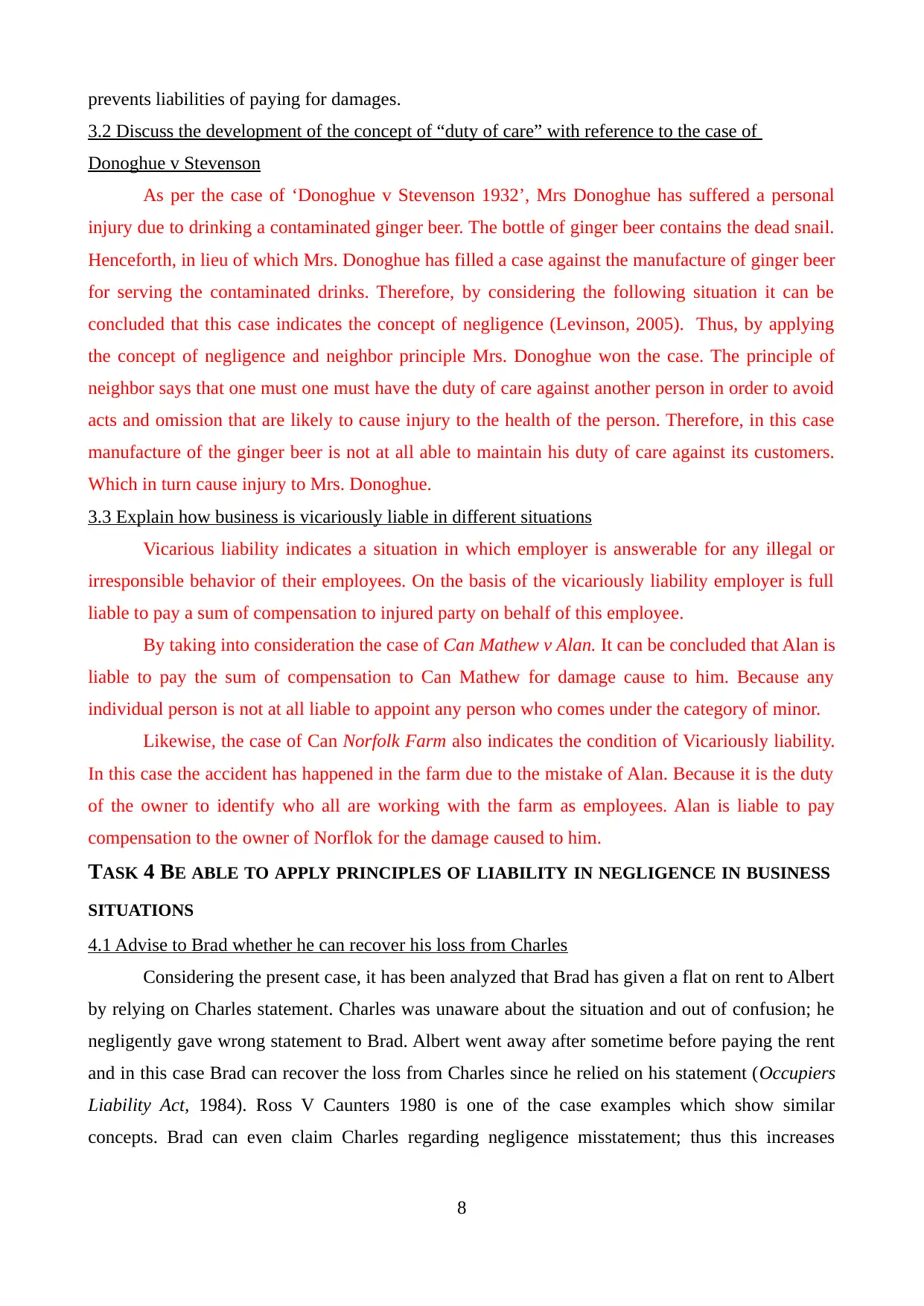
prevents liabilities of paying for damages.
3.2 Discuss the development of the concept of “duty of care” with reference to the case of
Donoghue v Stevenson
As per the case of ‘Donoghue v Stevenson 1932’, Mrs Donoghue has suffered a personal
injury due to drinking a contaminated ginger beer. The bottle of ginger beer contains the dead snail.
Henceforth, in lieu of which Mrs. Donoghue has filled a case against the manufacture of ginger beer
for serving the contaminated drinks. Therefore, by considering the following situation it can be
concluded that this case indicates the concept of negligence (Levinson, 2005). Thus, by applying
the concept of negligence and neighbor principle Mrs. Donoghue won the case. The principle of
neighbor says that one must one must have the duty of care against another person in order to avoid
acts and omission that are likely to cause injury to the health of the person. Therefore, in this case
manufacture of the ginger beer is not at all able to maintain his duty of care against its customers.
Which in turn cause injury to Mrs. Donoghue.
3.3 Explain how business is vicariously liable in different situations
Vicarious liability indicates a situation in which employer is answerable for any illegal or
irresponsible behavior of their employees. On the basis of the vicariously liability employer is full
liable to pay a sum of compensation to injured party on behalf of this employee.
By taking into consideration the case of Can Mathew v Alan. It can be concluded that Alan is
liable to pay the sum of compensation to Can Mathew for damage cause to him. Because any
individual person is not at all liable to appoint any person who comes under the category of minor.
Likewise, the case of Can Norfolk Farm also indicates the condition of Vicariously liability.
In this case the accident has happened in the farm due to the mistake of Alan. Because it is the duty
of the owner to identify who all are working with the farm as employees. Alan is liable to pay
compensation to the owner of Norflok for the damage caused to him.
TASK 4 BE ABLE TO APPLY PRINCIPLES OF LIABILITY IN NEGLIGENCE IN BUSINESS
SITUATIONS
4.1 Advise to Brad whether he can recover his loss from Charles
Considering the present case, it has been analyzed that Brad has given a flat on rent to Albert
by relying on Charles statement. Charles was unaware about the situation and out of confusion; he
negligently gave wrong statement to Brad. Albert went away after sometime before paying the rent
and in this case Brad can recover the loss from Charles since he relied on his statement (Occupiers
Liability Act, 1984). Ross V Caunters 1980 is one of the case examples which show similar
concepts. Brad can even claim Charles regarding negligence misstatement; thus this increases
8
3.2 Discuss the development of the concept of “duty of care” with reference to the case of
Donoghue v Stevenson
As per the case of ‘Donoghue v Stevenson 1932’, Mrs Donoghue has suffered a personal
injury due to drinking a contaminated ginger beer. The bottle of ginger beer contains the dead snail.
Henceforth, in lieu of which Mrs. Donoghue has filled a case against the manufacture of ginger beer
for serving the contaminated drinks. Therefore, by considering the following situation it can be
concluded that this case indicates the concept of negligence (Levinson, 2005). Thus, by applying
the concept of negligence and neighbor principle Mrs. Donoghue won the case. The principle of
neighbor says that one must one must have the duty of care against another person in order to avoid
acts and omission that are likely to cause injury to the health of the person. Therefore, in this case
manufacture of the ginger beer is not at all able to maintain his duty of care against its customers.
Which in turn cause injury to Mrs. Donoghue.
3.3 Explain how business is vicariously liable in different situations
Vicarious liability indicates a situation in which employer is answerable for any illegal or
irresponsible behavior of their employees. On the basis of the vicariously liability employer is full
liable to pay a sum of compensation to injured party on behalf of this employee.
By taking into consideration the case of Can Mathew v Alan. It can be concluded that Alan is
liable to pay the sum of compensation to Can Mathew for damage cause to him. Because any
individual person is not at all liable to appoint any person who comes under the category of minor.
Likewise, the case of Can Norfolk Farm also indicates the condition of Vicariously liability.
In this case the accident has happened in the farm due to the mistake of Alan. Because it is the duty
of the owner to identify who all are working with the farm as employees. Alan is liable to pay
compensation to the owner of Norflok for the damage caused to him.
TASK 4 BE ABLE TO APPLY PRINCIPLES OF LIABILITY IN NEGLIGENCE IN BUSINESS
SITUATIONS
4.1 Advise to Brad whether he can recover his loss from Charles
Considering the present case, it has been analyzed that Brad has given a flat on rent to Albert
by relying on Charles statement. Charles was unaware about the situation and out of confusion; he
negligently gave wrong statement to Brad. Albert went away after sometime before paying the rent
and in this case Brad can recover the loss from Charles since he relied on his statement (Occupiers
Liability Act, 1984). Ross V Caunters 1980 is one of the case examples which show similar
concepts. Brad can even claim Charles regarding negligence misstatement; thus this increases
8
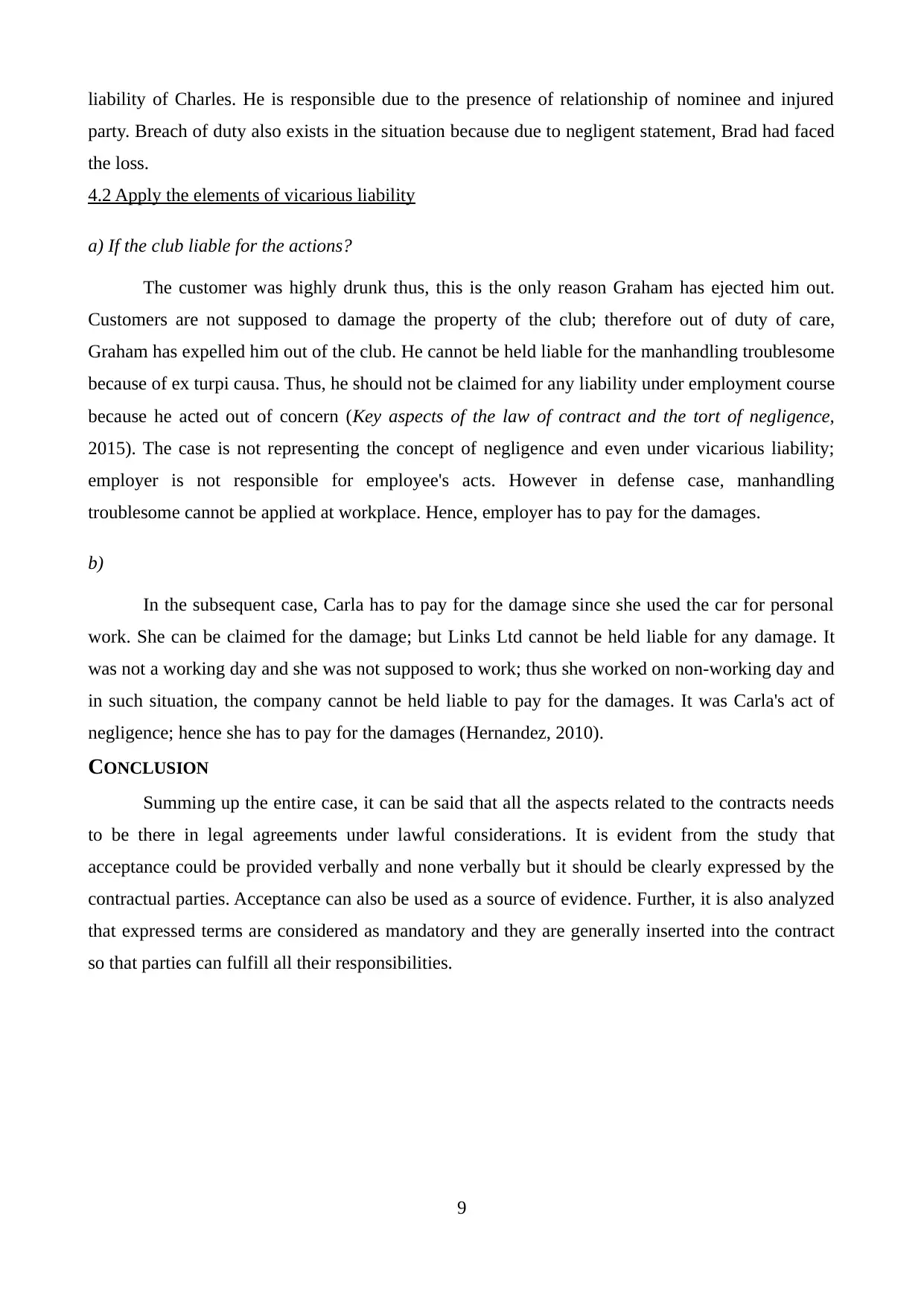
liability of Charles. He is responsible due to the presence of relationship of nominee and injured
party. Breach of duty also exists in the situation because due to negligent statement, Brad had faced
the loss.
4.2 Apply the elements of vicarious liability
a) If the club liable for the actions?
The customer was highly drunk thus, this is the only reason Graham has ejected him out.
Customers are not supposed to damage the property of the club; therefore out of duty of care,
Graham has expelled him out of the club. He cannot be held liable for the manhandling troublesome
because of ex turpi causa. Thus, he should not be claimed for any liability under employment course
because he acted out of concern (Key aspects of the law of contract and the tort of negligence,
2015). The case is not representing the concept of negligence and even under vicarious liability;
employer is not responsible for employee's acts. However in defense case, manhandling
troublesome cannot be applied at workplace. Hence, employer has to pay for the damages.
b)
In the subsequent case, Carla has to pay for the damage since she used the car for personal
work. She can be claimed for the damage; but Links Ltd cannot be held liable for any damage. It
was not a working day and she was not supposed to work; thus she worked on non-working day and
in such situation, the company cannot be held liable to pay for the damages. It was Carla's act of
negligence; hence she has to pay for the damages (Hernandez, 2010).
CONCLUSION
Summing up the entire case, it can be said that all the aspects related to the contracts needs
to be there in legal agreements under lawful considerations. It is evident from the study that
acceptance could be provided verbally and none verbally but it should be clearly expressed by the
contractual parties. Acceptance can also be used as a source of evidence. Further, it is also analyzed
that expressed terms are considered as mandatory and they are generally inserted into the contract
so that parties can fulfill all their responsibilities.
9
party. Breach of duty also exists in the situation because due to negligent statement, Brad had faced
the loss.
4.2 Apply the elements of vicarious liability
a) If the club liable for the actions?
The customer was highly drunk thus, this is the only reason Graham has ejected him out.
Customers are not supposed to damage the property of the club; therefore out of duty of care,
Graham has expelled him out of the club. He cannot be held liable for the manhandling troublesome
because of ex turpi causa. Thus, he should not be claimed for any liability under employment course
because he acted out of concern (Key aspects of the law of contract and the tort of negligence,
2015). The case is not representing the concept of negligence and even under vicarious liability;
employer is not responsible for employee's acts. However in defense case, manhandling
troublesome cannot be applied at workplace. Hence, employer has to pay for the damages.
b)
In the subsequent case, Carla has to pay for the damage since she used the car for personal
work. She can be claimed for the damage; but Links Ltd cannot be held liable for any damage. It
was not a working day and she was not supposed to work; thus she worked on non-working day and
in such situation, the company cannot be held liable to pay for the damages. It was Carla's act of
negligence; hence she has to pay for the damages (Hernandez, 2010).
CONCLUSION
Summing up the entire case, it can be said that all the aspects related to the contracts needs
to be there in legal agreements under lawful considerations. It is evident from the study that
acceptance could be provided verbally and none verbally but it should be clearly expressed by the
contractual parties. Acceptance can also be used as a source of evidence. Further, it is also analyzed
that expressed terms are considered as mandatory and they are generally inserted into the contract
so that parties can fulfill all their responsibilities.
9
⊘ This is a preview!⊘
Do you want full access?
Subscribe today to unlock all pages.

Trusted by 1+ million students worldwide
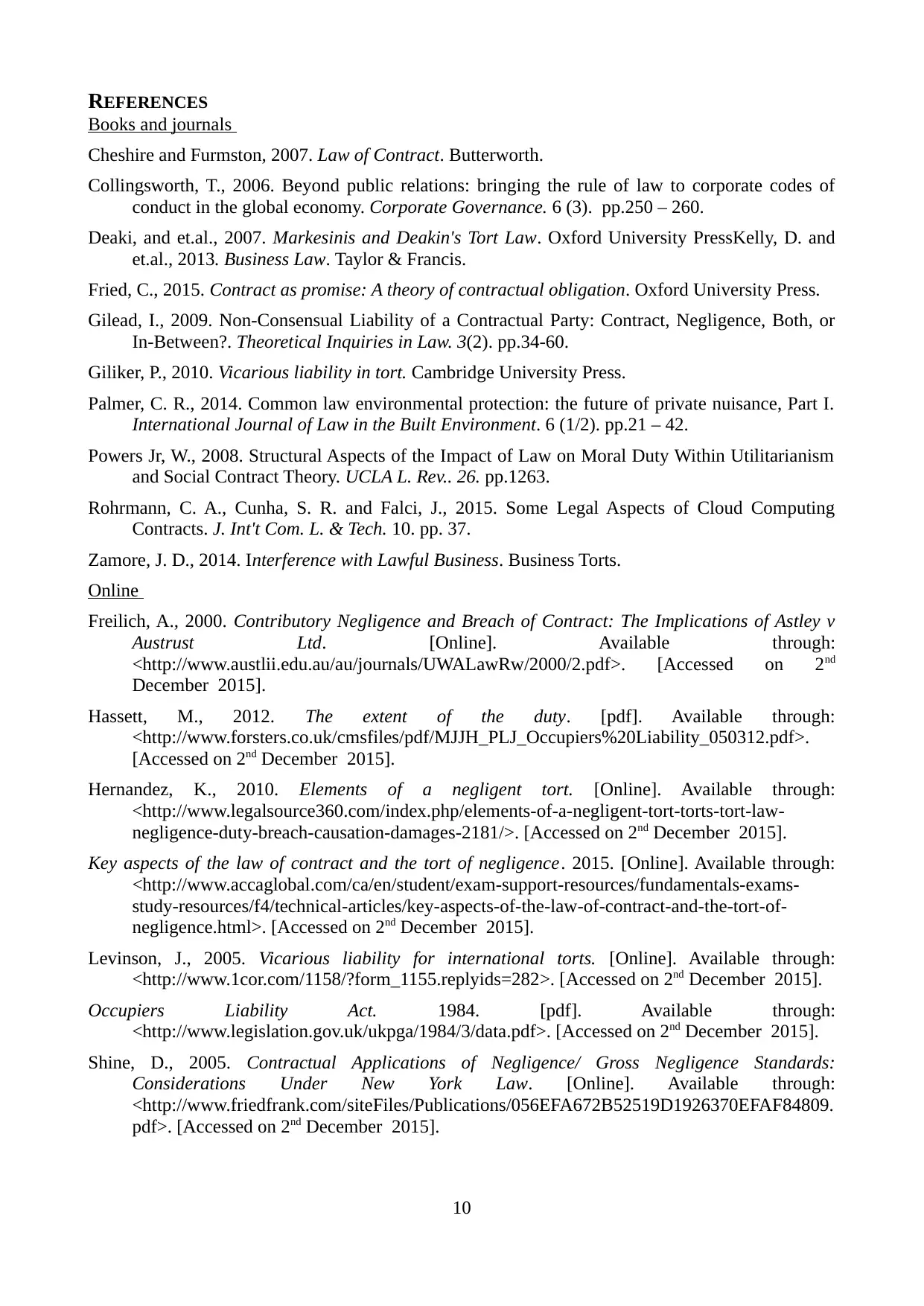
REFERENCES
Books and journals
Cheshire and Furmston, 2007. Law of Contract. Butterworth.
Collingsworth, T., 2006. Beyond public relations: bringing the rule of law to corporate codes of
conduct in the global economy. Corporate Governance. 6 (3). pp.250 – 260.
Deaki, and et.al., 2007. Markesinis and Deakin's Tort Law. Oxford University PressKelly, D. and
et.al., 2013. Business Law. Taylor & Francis.
Fried, C., 2015. Contract as promise: A theory of contractual obligation. Oxford University Press.
Gilead, I., 2009. Non-Consensual Liability of a Contractual Party: Contract, Negligence, Both, or
In-Between?. Theoretical Inquiries in Law. 3(2). pp.34-60.
Giliker, P., 2010. Vicarious liability in tort. Cambridge University Press.
Palmer, C. R., 2014. Common law environmental protection: the future of private nuisance, Part I.
International Journal of Law in the Built Environment. 6 (1/2). pp.21 – 42.
Powers Jr, W., 2008. Structural Aspects of the Impact of Law on Moral Duty Within Utilitarianism
and Social Contract Theory. UCLA L. Rev.. 26. pp.1263.
Rohrmann, C. A., Cunha, S. R. and Falci, J., 2015. Some Legal Aspects of Cloud Computing
Contracts. J. Int't Com. L. & Tech. 10. pp. 37.
Zamore, J. D., 2014. Interference with Lawful Business. Business Torts.
Online
Freilich, A., 2000. Contributory Negligence and Breach of Contract: The Implications of Astley v
Austrust Ltd. [Online]. Available through:
<http://www.austlii.edu.au/au/journals/UWALawRw/2000/2.pdf>. [Accessed on 2nd
December 2015].
Hassett, M., 2012. The extent of the duty. [pdf]. Available through:
<http://www.forsters.co.uk/cmsfiles/pdf/MJJH_PLJ_Occupiers%20Liability_050312.pdf>.
[Accessed on 2nd December 2015].
Hernandez, K., 2010. Elements of a negligent tort. [Online]. Available through:
<http://www.legalsource360.com/index.php/elements-of-a-negligent-tort-torts-tort-law-
negligence-duty-breach-causation-damages-2181/>. [Accessed on 2nd December 2015].
Key aspects of the law of contract and the tort of negligence. 2015. [Online]. Available through:
<http://www.accaglobal.com/ca/en/student/exam-support-resources/fundamentals-exams-
study-resources/f4/technical-articles/key-aspects-of-the-law-of-contract-and-the-tort-of-
negligence.html>. [Accessed on 2nd December 2015].
Levinson, J., 2005. Vicarious liability for international torts. [Online]. Available through:
<http://www.1cor.com/1158/?form_1155.replyids=282>. [Accessed on 2nd December 2015].
Occupiers Liability Act. 1984. [pdf]. Available through:
<http://www.legislation.gov.uk/ukpga/1984/3/data.pdf>. [Accessed on 2nd December 2015].
Shine, D., 2005. Contractual Applications of Negligence/ Gross Negligence Standards:
Considerations Under New York Law. [Online]. Available through:
<http://www.friedfrank.com/siteFiles/Publications/056EFA672B52519D1926370EFAF84809.
pdf>. [Accessed on 2nd December 2015].
10
Books and journals
Cheshire and Furmston, 2007. Law of Contract. Butterworth.
Collingsworth, T., 2006. Beyond public relations: bringing the rule of law to corporate codes of
conduct in the global economy. Corporate Governance. 6 (3). pp.250 – 260.
Deaki, and et.al., 2007. Markesinis and Deakin's Tort Law. Oxford University PressKelly, D. and
et.al., 2013. Business Law. Taylor & Francis.
Fried, C., 2015. Contract as promise: A theory of contractual obligation. Oxford University Press.
Gilead, I., 2009. Non-Consensual Liability of a Contractual Party: Contract, Negligence, Both, or
In-Between?. Theoretical Inquiries in Law. 3(2). pp.34-60.
Giliker, P., 2010. Vicarious liability in tort. Cambridge University Press.
Palmer, C. R., 2014. Common law environmental protection: the future of private nuisance, Part I.
International Journal of Law in the Built Environment. 6 (1/2). pp.21 – 42.
Powers Jr, W., 2008. Structural Aspects of the Impact of Law on Moral Duty Within Utilitarianism
and Social Contract Theory. UCLA L. Rev.. 26. pp.1263.
Rohrmann, C. A., Cunha, S. R. and Falci, J., 2015. Some Legal Aspects of Cloud Computing
Contracts. J. Int't Com. L. & Tech. 10. pp. 37.
Zamore, J. D., 2014. Interference with Lawful Business. Business Torts.
Online
Freilich, A., 2000. Contributory Negligence and Breach of Contract: The Implications of Astley v
Austrust Ltd. [Online]. Available through:
<http://www.austlii.edu.au/au/journals/UWALawRw/2000/2.pdf>. [Accessed on 2nd
December 2015].
Hassett, M., 2012. The extent of the duty. [pdf]. Available through:
<http://www.forsters.co.uk/cmsfiles/pdf/MJJH_PLJ_Occupiers%20Liability_050312.pdf>.
[Accessed on 2nd December 2015].
Hernandez, K., 2010. Elements of a negligent tort. [Online]. Available through:
<http://www.legalsource360.com/index.php/elements-of-a-negligent-tort-torts-tort-law-
negligence-duty-breach-causation-damages-2181/>. [Accessed on 2nd December 2015].
Key aspects of the law of contract and the tort of negligence. 2015. [Online]. Available through:
<http://www.accaglobal.com/ca/en/student/exam-support-resources/fundamentals-exams-
study-resources/f4/technical-articles/key-aspects-of-the-law-of-contract-and-the-tort-of-
negligence.html>. [Accessed on 2nd December 2015].
Levinson, J., 2005. Vicarious liability for international torts. [Online]. Available through:
<http://www.1cor.com/1158/?form_1155.replyids=282>. [Accessed on 2nd December 2015].
Occupiers Liability Act. 1984. [pdf]. Available through:
<http://www.legislation.gov.uk/ukpga/1984/3/data.pdf>. [Accessed on 2nd December 2015].
Shine, D., 2005. Contractual Applications of Negligence/ Gross Negligence Standards:
Considerations Under New York Law. [Online]. Available through:
<http://www.friedfrank.com/siteFiles/Publications/056EFA672B52519D1926370EFAF84809.
pdf>. [Accessed on 2nd December 2015].
10
1 out of 10
Related Documents
Your All-in-One AI-Powered Toolkit for Academic Success.
+13062052269
info@desklib.com
Available 24*7 on WhatsApp / Email
![[object Object]](/_next/static/media/star-bottom.7253800d.svg)
Unlock your academic potential
Copyright © 2020–2025 A2Z Services. All Rights Reserved. Developed and managed by ZUCOL.





